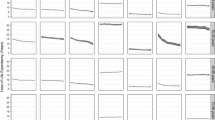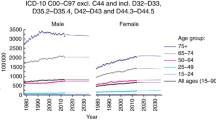Abstract
Age-conditional probabilities of developing a first cancer represent the transition from being cancer-free to developing a first cancer. Natural inputs into their calculation are rates of first cancer per person-years alive and cancer-free. However these rates are not readily available because they require information on the cancer-free population. Instead rates of first cancer per person-years alive, calculated using as denominator the mid-year populations, available from census data, can be easily calculated from cancer registry data. Methods have been developed to estimate age-conditional probabilities of developing cancer based on these easily available rates per person-years alive that do not directly account for the cancer-free population. In the last few years models (Merrill et al., Int J Epidemiol 29(2):197–207, 2000; Mariotto et al., SEER Cancer Statistics Review, 2002; Clegg et al., Biometrics 58(3):684–688, 2002; Gigli et al., Stat Methods Med Res 15(3):235–253, 2006, and software (ComPrev:Complete Prevalence Software, Version 1.0, 2005) have been developed that allow estimation of cancer prevalence (DevCan: Probability of Developing or Dying of Cancer Software, Version 6.0, 2005). Estimates of population-based cancer prevalence allows for the estimation of the cancer-free population and consequently of rates per person-years alive and cancer-free. In this paper we present a method that directly estimates the age-conditional probabilities of developing a first cancer using rates per person-years alive and cancer-free obtained from prevalence estimates. We explore conditions when the previous and the new estimators give similar or different values using real data from the Surveillance, Epidemiology and End Results (SEER) program.
Similar content being viewed by others
References
Campbell MK, Feuer EJ, Wun LM (1994) Cohort-specific risks of developing breast cancer to age 85 in Connecticut. Epidemiology 5(3): 290–296
Capocaccia R, De Angelis R (1997) Estimating the completeness of prevalence based on cancer registry data. Stat Med 16(4): 425–440
Clegg LX, Gail MH, Feuer EJ (2002) Estimating the variance of disease-prevalence estimates from population-based registries. Biometrics 58(3): 684–688
ComPrev:Complete Prevalence Software (2005) Version 1.0, statistical research and applications branch, National Cancer Institute. http://srab.cancer.gov/comprev
DevCan: Probability of Developing or Dying of Cancer Software (2005) Version 6.0, statistical research and applications branch, National Cancer Institute. http://srab.cancer.gov/devcan
Fay MP (2004) Estimating age-conditional probability of developing disease from surveillance data. Popul Health Metr 2(1): 6
Fay MP, Pfeiffer R, Cronin KA, Le C, Feuer EJ (2003) Age-conditional probabilities of developing cancer. Stat Med 22(11): 1837–1848
Feuer EJ, Wun LM, Boring CC, Flanders WD, Timmel MJ, Tong T (1993) The lifetime risk of developing breast cancer. J Natl Cancer Inst 85(11): 892–897
Gigli A, Mariotto A, Clegg LX, Tavilla A, Corazziari I, Hachey M et al (2006) Estimating the variance of cancer prevalence from population-based registries. Stat Methods Med Res 15(3): 235–253
Goldberg ID, Levin ML, Gerhardt PR, Handy VH, Cashman RE (1956) The probability of developing cancer. J Natl Cancer Inst 17: 155–173
Kalbfleisch JD, Prentice RL (1980) The statistical analysis of failure time data. Wiley, New York
Mariotto A, Gigli A, Capocaccia R, Tavilla A, Clegg L, Depry M et al (2002) Complete and limited duration cancer prevalence estimates. In: Ries L, Eisner M, Hankey B, Miller B, Clegg L, Edwards B (eds) SEER cancer statistics review, 1973–1999. National Cancer Institute, Bethesda
Merrill RM, Capocaccia R, Feuer EJ, Mariotto A (2000) Cancer prevalence estimates based on tumour registry data in the surveillance, epidemiology, and end results (SEER) Program. Int J Epidemiol 29(2): 197–207
Miller BA, Feuer EJ, Hankey BF (1994) The significance of the rising incidence of breast cancer in the United States. In: DeVita VT, Hellman S, Rosenberg SA (eds) Important advances in oncology. Lippincott Company, Philadelphia, pp 193–207
SEER Cancer Statistics Review, 1975–2002 (2005) In: Ries L, Eisner M, Kosary C, Hankey B, Miller B, Clegg L et al. (eds) National Cancer Institute. http://seer.cancer.gov/csr/1975_2002
Surveillance Research Program (2006) National Cancer Institute SEER*Stat software version 6.2.1. www.seer.cancer.gov/seerstat
Wun LM, Merrill RM, Feuer EJ (1998) Estimating lifetime and age-conditional probabilities of developing cancer. Lifetime Data Anal 4(2): 169–186
Zdeb MS (1977) The probability of developing cancer. Am J Epidemiol 106(1): 6–16
Author information
Authors and Affiliations
Corresponding author
Rights and permissions
About this article
Cite this article
Simonetti, A., Mariotto, A., Krapcho, M. et al. Improved population-based probability of developing cancer when direct estimates of the cancer-free population are available. Lifetime Data Anal 18, 284–301 (2012). https://doi.org/10.1007/s10985-012-9216-6
Received:
Accepted:
Published:
Issue Date:
DOI: https://doi.org/10.1007/s10985-012-9216-6




